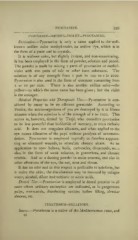Page 531 - My FlipBook
P. 531
PYOCTANINE. 529 ;
PVOCTANIN—METHYL-VIOLET—PYOCTANINE.
Derivation.—Pyoctanine is only a name applied to the well-
known aniline color methyl-violet, an aniline dye, which is in
the form of a paste and in crystals.
It is without color, but slightly irritant, and non-intoxicating.
It has been employed in the form of powder, solution and pencil.
The powder is made by mixing 2 parts of pyoctanine or methyl-
violet with 100 parts of talc or other inert substance. The
solution is of any strength from i part in 100 to i in 2000.
Pyoctanine is also used in the form of ointment containing from
2 to 10 per cent. There is also another aniline color—the
yellow—to which the same name has been given ; but the violet
is the stronger.
Medical Properties and Therapeutic Uses.—Pyoctanine is con-
sidered by many to be an efficient germicide. According to
Fessler, the micro-organisms of pus are destroyed by it in fifteen
minutes when the solution is of the strength of i to 1000. This
action is, however, denied by Troje, who considers pyoctanine
to be less powerful than bichloride of mercury, or even carbolic
acid. It does not coagulate albumen, and when applied to the
eye causes dilatation of the pupil without paralysis of accommo-
dation. Pyoctanine is emploved topically to disinfect suppura-
ting or ulcerated wounds, to stimulate chronic ulcers. As an
application to open buboes, boils, carbuncles, chancroids, etc.
also, in the form of weak solution, in gonorrhoea, and chronic
cystitis. And as a dusting powder in moist eczema, and also in
other affections of the eve, the ear, nose and throat.
It has no odor and in this respect is preferable to iodoform, but
it stains the skin ; the discoloration may be removed by cologne
water, alcohol, dilute hydrochloric or nitric acids.
Dental Uses.—Pyoctanine is employed in dental practice in all
cases where ordinary antiseptics are indicated, as in gangrenous
pulps, root-canals, disinfecting cavities before filling, alveolar
abscess, etc.
PYRETHRUM—PELLITORY.
Source.—Pyrethrum is a native of the Mediterranean coast, and
34


